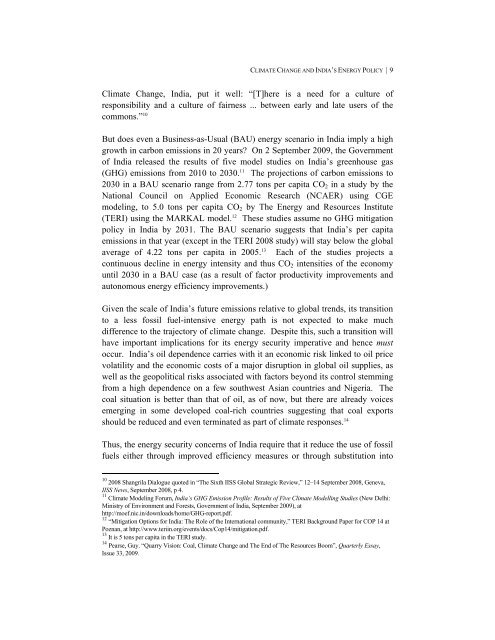Indian Climate Policy - Global Commons Institute
Indian Climate Policy - Global Commons Institute
Indian Climate Policy - Global Commons Institute
Create successful ePaper yourself
Turn your PDF publications into a flip-book with our unique Google optimized e-Paper software.
CLIMATE CHANGE AND INDIA’S ENERGY POLICY | 9<br />
<strong>Climate</strong> Change, India, put it well: “[T]here is a need for a culture of<br />
responsibility and a culture of fairness ... between early and late users of the<br />
commons.” 10<br />
But does even a Business-as-Usual (BAU) energy scenario in India imply a high<br />
growth in carbon emissions in 20 years? On 2 September 2009, the Government<br />
of India released the results of five model studies on India’s greenhouse gas<br />
(GHG) emissions from 2010 to 2030. 11 The projections of carbon emissions to<br />
2030 in a BAU scenario range from 2.77 tons per capita CO 2 in a study by the<br />
National Council on Applied Economic Research (NCAER) using CGE<br />
modeling, to 5.0 tons per capita CO 2 by The Energy and Resources <strong>Institute</strong><br />
(TERI) using the MARKAL model. 12 These studies assume no GHG mitigation<br />
policy in India by 2031. The BAU scenario suggests that India’s per capita<br />
emissions in that year (except in the TERI 2008 study) will stay below the global<br />
average of 4.22 tons per capita in 2005. 13 Each of the studies projects a<br />
continuous decline in energy intensity and thus CO 2 intensities of the economy<br />
until 2030 in a BAU case (as a result of factor productivity improvements and<br />
autonomous energy efficiency improvements.)<br />
Given the scale of India’s future emissions relative to global trends, its transition<br />
to a less fossil fuel-intensive energy path is not expected to make much<br />
difference to the trajectory of climate change. Despite this, such a transition will<br />
have important implications for its energy security imperative and hence must<br />
occur. India’s oil dependence carries with it an economic risk linked to oil price<br />
volatility and the economic costs of a major disruption in global oil supplies, as<br />
well as the geopolitical risks associated with factors beyond its control stemming<br />
from a high dependence on a few southwest Asian countries and Nigeria. The<br />
coal situation is better than that of oil, as of now, but there are already voices<br />
emerging in some developed coal-rich countries suggesting that coal exports<br />
should be reduced and even terminated as part of climate responses. 14<br />
Thus, the energy security concerns of India require that it reduce the use of fossil<br />
fuels either through improved efficiency measures or through substitution into<br />
10 2008 Shangrila Dialogue quoted in “The Sixth IISS <strong>Global</strong> Strategic Review,” 12–14 September 2008, Geneva,<br />
IISS News, September 2008, p 4.<br />
11 <strong>Climate</strong> Modeling Forum, India’s GHG Emission Profile: Results of Five <strong>Climate</strong> Modelling Studies (New Delhi:<br />
Ministry of Environment and Forests, Government of India, September 2009), at<br />
http://moef.nic.in/downloads/home/GHG-report.pdf.<br />
12 “Mitigation Options for India: The Role of the International community,” TERI Background Paper for COP 14 at<br />
Poznan, at http://www.teriin.org/events/docs/Cop14/mitigation.pdf.<br />
13 It is 5 tons per capita in the TERI study.<br />
14 Pearse, Guy. “Quarry Vision: Coal, <strong>Climate</strong> Change and The End of The Resources Boom”, Quarterly Essay,<br />
Issue 33, 2009.
















